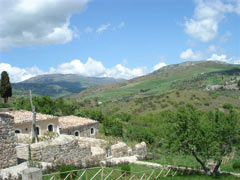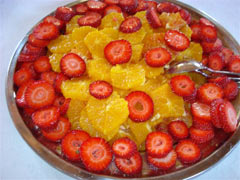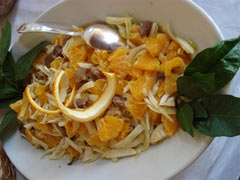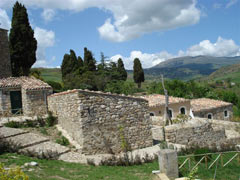Journeys with Carole Kotkin
A Taste of Sicily


Carole Kotkin is a syndicated Miami Herald food columnist and co-author of “MMMMiami – Tempting Tropical Tastes for Home Cooks Everywhere.” She is also the manager of The Cooking School at The Ocean Reef Club, food editor for “The Wine News” magazine, and co-host of “Food and Wine Talk” on southfloridagourmet.com.

Sicily is one of the Mediterranean’s most intriguing destinations, unique unto itself rather than a mere “part of Italy.” It’s a land of breathtaking coasts and lush tropical greenery, of layered cultures, fallen empires, and ancient myths.
Sicily’s vast culinary traditions are as diverse as the inhabitants and history of this island. The gastronomic heritage reflects a melting pot of influences and an endless array of exciting recipes.

I recently traveled to Palermo to attend an international Oldways Symposium on the Mediterranean Diet. Oldways is the widely respected nonprofit “food issues think tank” praised for translating the complex details of nutrition science into the familiar language of food. While there, I got a first-hand look at the Sicilian diet.
Sicily’s Mediterranean diet is consistently labeled as one of the healthiest diets in the world – a traditional pattern of healthy eating that consists of consuming lots of fruits, vegetables, pastas, grains, beans, nuts, a little red wine and always olive oil and garlic.
The signature dishes of Palermo are different from those of Catania, which are again distinct from those of Trapani. There are also classic dishes that are widely popular island-wide: pasta alla norma (with eggplant, ricotta salata, and tomato), all manner of swordfish and tuna, cassata (a rich, ricotta-based cake), and cannoli.
From North Africa came couscous and spicy stews. From the Mediterranean of the ancients came a taste for sweet-salt-tart combinations reflected in the eggplant and tomato caponata di verdure, bright salads of sweet oranges, red onion and black pepper; and pasta con le sarde, a sauce of wild fennel, raisins and nuts with anchovies and sardines.
The Strait of Messina, which separates Sicily from the mainland, is one of the world’s great fishing areas. Swordfish, sardines, and anchovies are found everywhere. The best known Sicilian seafood dish is spaghetti con sarde, tossed with sardines and olive oil. Most fish is simply grilled or roasted, perhaps drizzled with a little olive oil or marinated first with white wine and herbs, and perhaps garnished with olives or a wedge of lemon. Dishes are perfumed with cinnamon, anise and clove and scented with basil, rosemary and garlic.

Wheat, along with some other grains, has been the mainstay of Sicilian agriculture for 2,000 years. Scholars believe pasta was created in Sicily 1000 years ago. It is usually served with vegetables, seafood, cheese or meat sauce and can be the first course or the whole meal, but it’s always present. No Sicilian meal is complete without a loaf of bread, usually made from semolina flour or a bottle of olive oil.
Sicilians take their olive oils very seriously. Just ask noted Italian cookbook author, Nancy Harmon Jenkins (The Oldways Table), who writes, “Mediterranean cooks happily use olive oil for all their cooking needs, from braising to roasting to deep-fat frying, and wouldn’t dream of using anything else.”
Sicily’s citrus crop is very important, especially lemons, that show up in many Sicilian desserts. The infamous Sicilian sweet tooth dates back to the cultivation of sugarcane, without which there would be no cannoli, no marzipan, no nougat, no candied fruit, no cassata, and no gelato. Sicily’s ubiquitous almond-based cookies and sweets are well known.

A pilgrimage to bazaar-like Catania and Vucciria markets in Palermo are a must. Fish stalls are crowned with swordfish; vegetable sellers display mounds of artichokes complete with stalks, pyramids of oranges and hillocks of green cauliflowers between mountains of fava beans. Olives glistened in trays adorned with sprigs of rosemary. The entire digestive systems of goats and cows were hung at head height with livers, kidneys and stomachs attached as if to guarantee their origin.
Sicily’s warm, dry climate, sloping hillsides and rocky soil make it ideal for growing grapes—on par with California’s Napa Valley. A new generation of 17 Sicilian DOC wines such as Eloro, Etna, Alcamo, and Santa Margherita di Belice are gaining worldwide recognition. Marsala, one of the most famous dessert wines in the world is made in the province of Trapani.
Where to Eat

Ristorante La Scuderia, Viale del Fante 9, Palermo, 39 091 520323
Azienda Fantanasalsa, Agriturisimo near Segesta, 39 0923 591001, www.fontanasalsa.it
Antica Focacceria San Francisco, 58 Via Paernostro, 091-330264. Their specailities include guasteddu (a spleen sandwich), arancini (rice balls), and panelle (fried chickpea dough).
Where to Stay

Hilton Grand Hotel Villa Iglea Palermo, (39 091 631 2111, sales.villaigiepalermo@hilton.com) features spacious rooms overlooking the Gulf of Palermo; internet access, swimming pool, tennis court and fitness room. It’s necessary to take a cab into the center of town.
Masseria San Giovanni Sgadari, Agrituristica (39 091 687190, www.masseriasgadari.com) is a country house in the middle of an extensive country estate midway between Palermo and Catania. There are six apartments in which to enjoy the enchanting landscape.
Azienda Fantanasalsa, Agriturisimo near Segesta, (39 0923 591001, www.fontanasalsa.it) is a farm resort overlooking the farm’s olive grove, the sea, the Egadi islands and Mount Erice in the province of Trapani.


